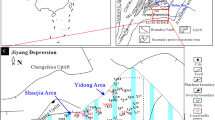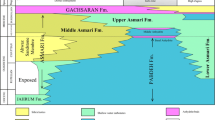Abstract
Compared with marine carbonate, lacustrine carbonate is limited in distribution globally; moreover, as an unconventional kind of carbonate, it cannot be evaluated and identified with conventional methods, so less attention has been paid and fewer studies have been made on it. However, according to exploration experiences all over the world, lacustrine carbonate can be an important source rock and reservoir rock in some cases. Qaidam basin, a large salt-water lake basin, had the lacustrine mixed deposition setting to form complex carbonate reservoirs. The recently found Neogene lacustrine algal limestone is an exploration target worthy of attention. The author has used drilling and well logging data to identify lacustrine algal limestone. The method is of great significance for the exploration and development of lacustrine carbonate in other areas.
Similar content being viewed by others
Avoid common mistakes on your manuscript.
Introduction
Mixed deposition is a special deposition phenomenon, in which sediments formed by terrigenous clastics and carbonates (including allochemical grains, etc.) can be a set of rock combination, or a combination of rock layer systems (Guo et al. 2003). Consensus has not yet reached about the origins and classification of the mixed sediments (Feng 1993; Sha et al. 2001; Ma and Liu 2003; Guo et al. 2003; Zhang et al. 2000). Zhang (2000); Wang (2001) believes diamictite is the result of mixing caused by sudden events, gradual changes at facies margin, in-place deposition, erosion and redeposition, and palaeokarst. Modern deposition produces this kind of mixed sediment too, which has some unique features (Zhao 2013a; Wang 2010).
The Neogene salt-water lake deposits in the Qaidam basin have typical features of mixed sedimentation (Ulmishek 1984); Dang and Zhao (2004) . The sedimentary source of northwestern Qaidam basin Neogene reservoir mainly came from the Arytin Mountain (Zhao 2013b); Hanson et al. (2001), a far away source area. Developing in an arid-semiarid climate, the Neogene reservoir is a kind of mixed sediment rock formed by alternating chemical and mechanical actions during the phase of lake water turning from slightly brackish water to brackish water (Tuo et al. 1995). According to current understanding of mixed deposition, and studies of the Neogene in the western Qaidam basin, the author identified mixed carbonate by logging and imaging (Fig. 1) (Xu 2007; Yang 2010).
Lacustrine carbonate of mixed deposits identification methods
Identification of lacustrine carbonate lithology with conventional log
Carbonate deposited in lacustrine mixed sedimentary environment is principally made up of sandstonean, carbonate, mudstoned the mixture of the three, in which reservoirs are dominated by algal limestone and sandstone (Fig. 2).
Determination of rock composition with three porosity logging
Based on lithology-physical model, the lithology components are determined. On the basis of three porosity logs, the contents of mudstone, carbonate and sandstone are calculated with petrophysical methods like material balance equation.
where V 1, V 2, V 3, Φ f are the framework volume of component one, component two, component three and pore fluid space in the rock;
ρ 1, ρ 2, ρ 3, ρf are the framework density response of component one, component two, component three and pore fluid in the rock;
CN1, CN2, CN3, CNf are netron framework response of component one, component two, component three and pore fluid in the rock;
T 1, T 2, T 3, T f are acoustic framework curve of component one, component two, component three and pore fluid in the rock;
ρ b, CNb, Tb are log response value of density, netron, acoustic;
Φ f is volumes of pore fluid;
1 is the total volume;
Component one is the contents of mudstone, component two is the contents of carbonate, component three is the contents of sandstone (Fig. 2).
Calculation of clay content with core calibration logging
In shale content calculation, shale content from core analysis and relative gamma ray are used to build a calibration model. When spectroscopy gamma ray is available, gamma ray value free of uranium is used in calculation. The calculation model is as follows:
where V sh—shale content, %; △GR—relative value of gamma ray.
Calculation of carbonate content by using flush zone resistivity
Carbonate components usually exist in cement or cementation state, so cementation degree is closely related to carbonate content (Fig. 3).
where C—wellbore environment, Φ—porosity data, obtained by acoustic logging, M—pore cementation exponent, affected by carbonate content, porous structure exponent,
For shallow lake sedimentary environment, the variation in cementation degree can be reflected by carbonate content, and displayed on shallow lateral resistivity in the end, flushed zone resistivity can be obtained by core calibration logging, which will then be used to calculate carbonate content:
Carbonate reservoir physical properties parameter determination
To reduce influence on porosity by shale, generally, use acoustic logging curve, porosity obtained by empirical formula:
where, Por logging calculating porosity (%) (Fig. 2). T acoustic logging value, R Relation coefficient, N Number of samples.
The calculating permeability use conventional way for the marl limestone, algal limestone empirical formula:
where, Perm logging calculating permeability (Fig. 2). Por logging calculating porosity, V sh clay content (%), R s shallow resistivity, R d deep resistivity.
Use Archie equation to obtain the oil saturation (Fig. 4),
Imaging identify lithology of lacustrine carbonate
Formation micro-resistivity imaging (FMI) plays a crucial role in the lithology identification of lacustrine carbonate and the understanding of special geologic phenomena.
Carbonate in lacustrine mixed sediments is primarily the product of algal organism deposition and generally includes algal limestone mass (Fig. 5a), laminated algal limestone (Fig. 5b), and algal micritic limestone (Fig. 5c).
Mudstones in lacustrine sediments take on black parallel bands on FMI image. Calcareous mudstone is black mudstone with small amount of bright calcic. Marl is black and white bands on dynamic image, and marl differs from mudstone in that it is bright on a static image (Fig. 5d).
Conclusions
Different from simple marine carbonate and continental sandstone, the lacustrine carbonates of mixed sediments in western Qaidam are complex and without pure carbonate, siltstone or mudstone.
Sedimentary modes involve mechanical deposition, chemical deposition and biological deposition. Carbonate, siltstone and mudstone principally form distinctive interbeddings, with small thickness (at millimeter scale in general), reflecting frequent alternation of depositional differentiation in vertical direction, short depositional cycle, and fast change, which may be related to the seasonal climate changes in this area. The sediments are mainly carbonate and mudstone in an arid climate on the whole.
Mixed deposition in lake facies makes study of lacustrine carbonate more difficult; this study introduces the lacustrine carbonate identification method with logging and imaging, which has achieved good results in exploration.
References
Dang YQ, Zhao DS (2004) Sedimentary facies of the Paleogene and Neogene in western Qaidam basin. J. Palaeogeogr. 6(3):297–306 (in Chinese)
Feng ZZ (1993) Sedimentary Petrology. Beijing Petroleum Industry, Beijing (in Chinese)
Guo FS, Yan ZB, Du CS (2003) Discuss about admixture sedimentary, diamictite and admixture layer. Earth Sci Front 10(3):40–44 (in Chinese)
Hanson AD, Ritts BD, Zinniker D, Moldowan JM, Biffi U (2001) Upper Oligocene lacustrine source rocks and petroleum systems of the northern Qaidam basin, northwest China. AAPG Bull 85(4):601–619
Ma YP, Liu L (2003) Sedimentary and diagenesis characteristics of Paleogene lacustrine “Hunji” Rock in beach district, Dagang. Acta Sedimentologica Sinica 21(4):607–613 (in Chinese)
Sha AQ (2001) An example of hunji rock-origin of sandy doloarenite of the formation in eastern Yunnan province. J Palaeogeogr 4(3):56–60 (in Chinese)
Tuo JC, Shao HS, Huang XZ (1995) Lacustrine carbonate source rock and its organic geochemical characteristics: an example from the Neogene in the Qaidam basin. Exp Petrol Geol 17(3):273–276 (in Chinese)
Ulmishek G (1984) Geology and petroleum resources of basins in western China: Argonne National Laboratory report ANL/ES-146, Argonne, Illinois, pp 131–138
Wang GZ (2001) Mixed sedimentation of recent reefoid carbonates and terrigenous clastics in the north continental shelf of the South China Sea. J Palaeogeogr 3(2):47–54 (in Chinese)
Wang GL (2010) Sulfur rich petroleum derived from lacustrine carbonate source rocks in Bohai Bay Basin, East China. Org Geochem 41:340–354. doi:10.1016/j.orggeochem.2009.12.010
Xu C (2007) Interpreting shoreline sands using borehole images—a case study of the Cretaceous Ferron sands in Utah. AAPG Bull 91:1319–1338
Yang RJ (2010) Distribution and formation mechanism of lime mudstone in Upper Triassic in northwestern Sichuan, China. Carbonates Evaporites 25:275–281. doi:10.1007/s13146-010-0035-0
Zhang XH (2000) Classification and origin of mix sedimentite. Geol Sci Technol Inf 19(4):31–34 (in Chinese)
Zhao F (2013a) Lacustrine algal limestone reservoir in western Qaidam basin, China. Carbonates Evaporates. doi:10.1007/s13146-013-0182-1
Zhao F (2013b) Meso-Cenozoic tectonic evolution of Qaidam basin and its relationship with oil and gas accumulation. Nat Gas Geosci 24(25):940–947 (1672-1926(2013)05-0940-08)
Author information
Authors and Affiliations
Corresponding author
Rights and permissions
About this article
Cite this article
Zhao, F. Identification of Neogene mixed lacustrine carbonate in western Qaidam basin. Carbonates Evaporites 30, 281–285 (2015). https://doi.org/10.1007/s13146-014-0210-9
Accepted:
Published:
Issue Date:
DOI: https://doi.org/10.1007/s13146-014-0210-9









